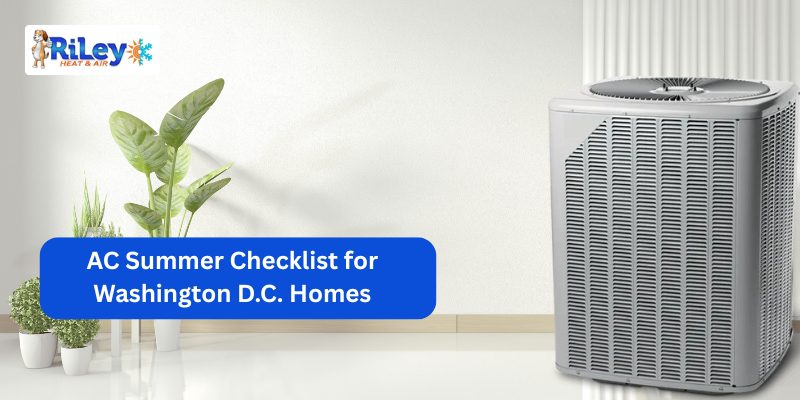
What to Include in Your AC Summer Checklist (Washington, D.C.)
Summers in Washington, D.C. are known to be hot, humid, and brutal, and a good air conditioner is something that is needed. Preventative AC servicing prior to the high temperatures setting in could spell the difference between easy comfort and an expensive repair.
The summer checklist is a well-designed tool that can guide your system to work effectively, reduce energy bills, and keep you cool. How to get your AC ready to beat the heat? Let us find out.
AC Summer Checklist for Washington D.C. Residents
1. Replacement or change of Air Filters
Air filters that are clogged slow down airflow and decrease the efficiency of cooling, and also make the working process with your AC system too hard. During humid summer in Washington, D.C., filters can become clogged with dust, pollen, and indoor pollutants. Strongly, it is recommended that they should be checked once a month and be changed or cleaned every 30-60 days.
Replacement of the filter provides you with a cool indoor air supply and dependable cooling. It also keeps off allergens and dust buildup—all common issues with Washington D.C.’s old houses. Maintenance for this easy task considerably enhances both your AC’s efficiency and your residence’s indoor air quality.
2. Cleaning of Outdoor Unit Condenser
Tree-shaded streets and populated urban neighborhoods in Washington, D.C., clog outdoor AC units with pollen, debris, and leaves. A clogged condenser is not allowed to release that heat effectively, so your system is not quite so efficient. Remove material from the unit and hose it off carefully with a garden hose without slamming.
This cleaning procedure enables more air flow, as it enables more effective cooling for your system. Ensure that one switches off the power while getting one's hands dirty with cleaning. A cleaned condenser does more than improve performance; it also extends life for AC on D.C.’s driest summer days.
3. Track Thermostat Readings
Install a timer for an energy-saving aspect for your thermostat while still being comfortable in your home. In Washington, D.C., with possible quick changes of weather, a smart thermostat makes automatic changes so that you get energy efficiency while being comfortable.
Raise the thermostat when away from the cooling expense. A couple of degrees make a big difference in the long term. If in a Capitol Hill townhouse or a Georgetown condominium, smart control assists with control of indoor comfort with Washington, D.C.’s changing summer weather.
4. Check Refrigerant Lines for Leaks
Check for refrigerant leaks if you notice ice on wires, hissing sounds, or hot air from your AC. Low refrigerant does more than suck down cooling power—it makes a compressor run overtime and potentially crash a system.
Leaks occur most frequently for older D.C. systems or with excessive usage. Do not attempt to deal with refrigerants yourself—request the services of a professional HVAC technician. Early identification prevents long-term harm, allows good cooling, and allows comfortable interior temperatures for record highs in Washington's summer temperatures.
5. Open Up and Check Air Vents and Registers
Jammed vents also slow cooling flow and decrease system efficiency. Ensure no furniture, drapes, or rugs are blocking any air registers in a residence. Circulation is necessary for even cooling, particularly with multi-level set-ups common for Washington D.C. rowhomes and townhomes.
It is a good idea to vacuum vents regularly and wipe down all the vent openings. Unfilled vents enable equalization of the cold air with the interior air quality control of your house, leaving your interior space warmer and fresher throughout the year.
6. Testing System Performance
Do not wait until D.C.’s most scorching week to realize that your AC is not quite in sync. Use it late spring or early summer and pay attention for odd sounds, verify for good airflow, and make sure chilled air is being circulated. Pre-season inspections allow hidden problems to be determined before they turn into big ones.
Having small problems under control early allows for less surprise downtime and less emergency repair risk when demand is highest. In a town like D.C., with HVAC technicians having been booked up fast in the middle of heatwaves, that one upfront investment ensures you do not sit idly by waiting for service in the wintertime.
7. Schedule a Professional Tune-Up
Standard yearly summer tune-up for an experienced HVAC professional consists of a refrigerant level check, electric component inspection, coil cleaning, and system operability check. Tune-ups become a must for D.C., urban microclimate units, concentrated stock housing units, and aging equipment.
Scheduling service early in demand months ensures that a slot is available for your technician. Licensed locals also comprehend local climatic demands and stock diversity from aging brownstones to new condominiums. You can stop unexpected breakdowns while ensuring that your AC works efficiently the whole summer season with preventive maintenance.
8. Check for Leaks or Holes in Ducts
Most Washington, D.C. homes also contain aging ducts that will eventually become clogged or develop leaks due to age. Leaking ducts mean nonuniform cooling, lost air flow, and a potential drastic increase in your utility bill as your system makes up for lost air.
Sealing or duct insulating retains lost cold air and makes a duct system more efficient. It is particularly requested for aged houses that contain crawlspaces or attic spaces. A professional ductwork analysis provides optimum cooling, more levels of comfort, and minimum operating expenses for long humid summers.
9. Improve Weatherproofing and Insulation
An AC system can be the best in the market, but it still would not work when cold air is leaking through insufficiently insulated walls, ceilings, or windows. Washington, D.C., where fall and summer storms take their toll on equipment and where humidity is not uncommon, sealing air leaks with caulk can make a big difference.
Insulate better, caulk around windows and doors to ensure cool air within and hot air outside. In addition to getting optimal output from your system, this ensures that you have a consistent interior temperature during heatwaves and humid afternoons.
Conclusion
Routine air conditioning service is the best way to remain cool, save energy, and prevent expensive repairs throughout hot Summer days and nights in Washington, D.C. With the help of this checklist, you will be in a position to keep this system in its right working condition when you need it most.
For professional service and top services, contact Riley Heat & Air—your Washington, D.C., trusted HVAC experts.
Tags :






